2012 VOLKSWAGEN GOLF PLUS Break
[x] Cancel search: BreakPage 16 of 541

Turn signal s or right.
Emerg ency sw itch ed on.
gear s
Depr ess brake pedal!
page 188
High beams swi tched on or headli ght in use .
High be a m control (Light Assis t) on.
Elec tron ic immobili zer active.
Serv ic e int erva l di splay.
to heed warning ligh ts and instrument cluster text messages can cause the vehicle to break down in traffic and result in a collision and serious personal injury.
Never ignore warning lights or text WARN
Always stop th e vehicle as soon as it is safe to do so.
the vehicle at a safe distance from moving traffic and where no part of the hot cata
lyti c converter and exhau st sys tem can come into contact w ith brush, spilled fuel,
e tc .
Instrument
172
A broken down vehicle presents a high accident risk for itself and others. on emerge ncy flashers and set up
Before opening the engine hood, switch the en gine and let the engine cool down.
Be very careful when working in the engine compartment, which is
14 15
Page 19 of 541
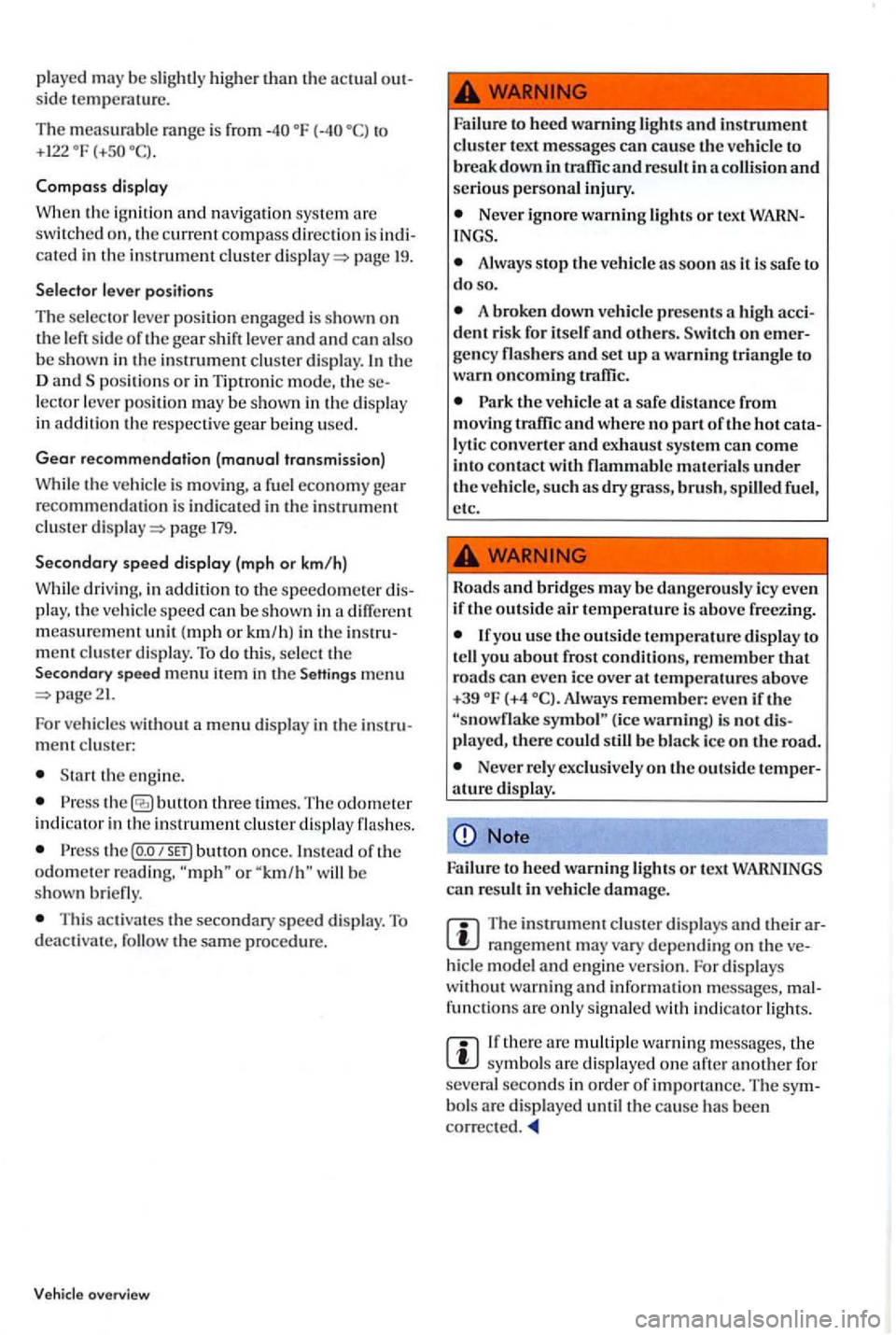
playe d m ay be slightly hi gher the
is from { to +122
cated in the instrument clu ste r pag e 19.
lec tor leve r po sition may be s hown in th e disp la y
in addition th e respective gear bein g use d.
Gear re commendation (manual transmission)
While the vehicle is movin g, a fuel eco nomy gear
recomme ndation is ind icate d in the in strument
clu ste r p age 179.
Secondary speed display (mph or km/h)
While drivin g, in addition to the speedomete r play, th e vehicl e speed can b e shown in measurem ent unit {mph or km /h ) in the ment clu ste r d is play. T o do thi s, se lec t th e
Seco ndary sp ee d menu item in pagc21.
For vehicles wit ho ut a m enu displa y in the ment cluste r:
th e engine.
button three tim es. The odometer
in dica to r in th e in strument clu ste r di sp lay flas h es .
the (o.o SET) bu tton once. Instead of th e odom eter reading. or
Thi s th e secondary sp ee d di splay. To d eac tiva te. follow th e same pro cedure.
overview
Failur e to hee d warnin g light s and instrument cluster text messages can cause the ve hicl e to break down in traffic and res ult in a colli sion and
se riou s personal injury .
Never ignore warning lights or tex t INGS.
Always stop the vehicle as soo n as it is safe to do so.
A broken down veh icle presents high dent risk for itself and Sw itch on gency flash e rs and se t up a w arnin g tr iangle to warn oncoming
Park the vehicle at and where no ly ti c co nverte r and exhaust sys te m can come into contact witl1 flammable materials under
th e vehicl e, s u ch as dry brus h, spilled fuel ,
e tc.
yo u usc the temperature disp lay to
t ell yo u about frost condition s, remember that road s can even icc ov er at temperatures above
+39 {+4 {ice warning) is not
Neve r rel y exclusively on the o utside ature disp lay.
Note
Failure to heed warning lights or tex t WARNINGS
ca n res ult in vehicle damage.
The in strument cluste r disp lays and their rangement may vary dep e nding on th e hide model and e ng in e ve rs ion. For disp lay s
witho ut wa rnin g and in formation messages, fun ction s are only s igna le d w ith indicator lights .
there arc multipl e wa rnin g m ess age s, the sy mbo ls are dis p layed one aft er anothe r for
seve ra l se conds in orde r of importan ce. The bol s are di splay ed un til the cause has been correc ted.
Page 43 of 541
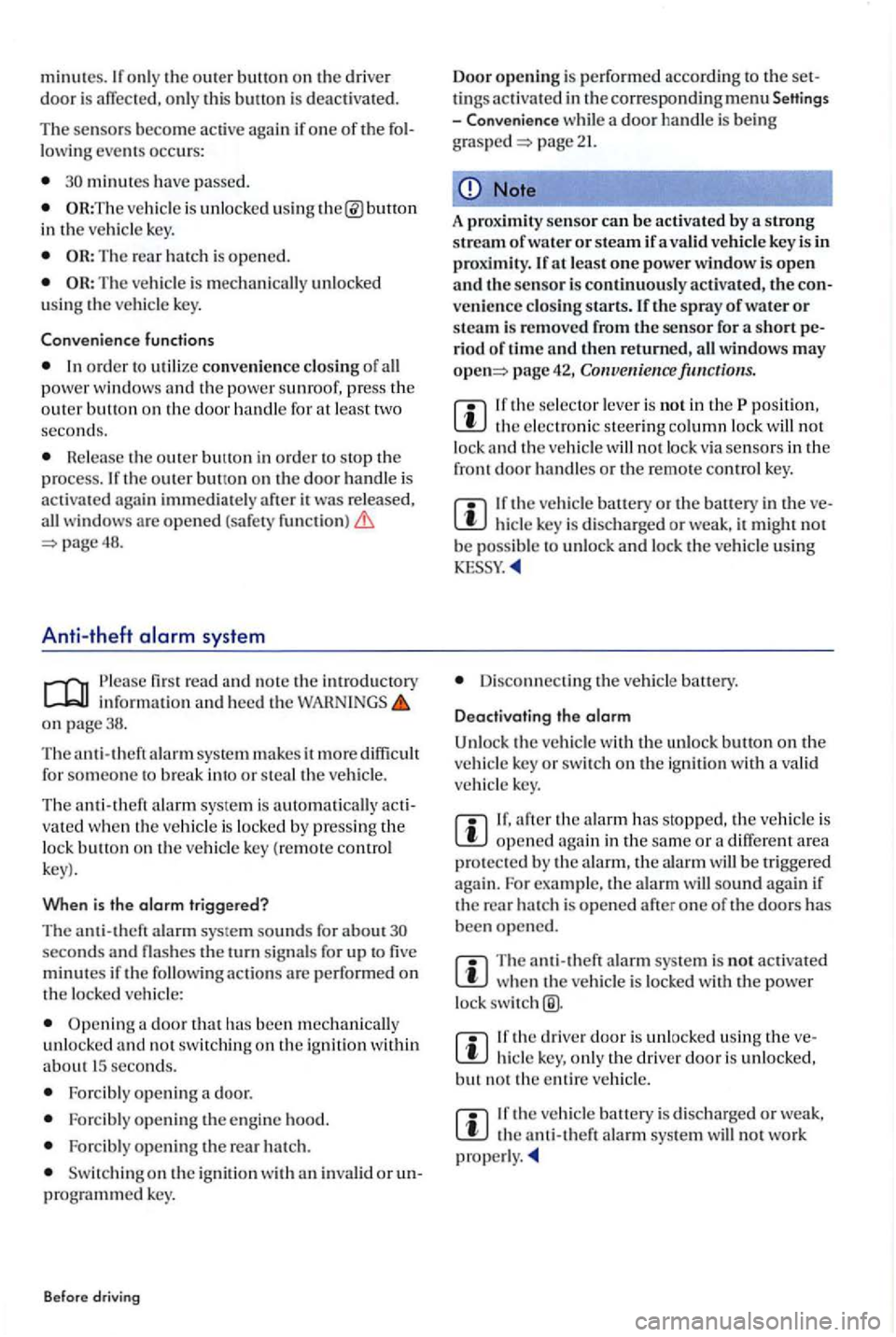
minutes. onl y the outer button on the driver door is affected, o nl y thi s button is deactivat ed.
The sensors become active again if one of the following events occurs:
minutes have pass ed.
OR:The vehicle is unlocked usin g button in the vehicle key.
order to uti lize convenience closing of all power window s and the power sunroof. press the outer button on the door handle for at least
the outer button in ord e r to stop the process.lfthe outer button on th e door handle is acti va te d a gain immedia te ly aft er it relea sed,
all windows are ope n ed (safe ty fun cti on) page 48.
Anti-theft system
lir st read and note the introduc tory information and heed the on page38.
The anti-theft alarm sys te m makes it more difficult
for someon e to break into or ste al the vehicl e.
The anti-theft alarm system is automati cally acti vated when th e ve hicle is locke d b y pressing the lock button on th e vehicle key (remote control
k ey).
When is the alarm trigg ered?
The anti-theft a larm system sounds fo r ab out seconds and fla shes the turn signals fo r up to minutes if the f ollowing a c ti ons are performed on the locke d vehicl e:
Opening been mechanic ally unlo cke d and not swit ching on the ig n ition w ithin about
Forcibl y opening a door.
Forcibl y opening the engin e hood.
Forcibl y opening the rear h atc h .
on the ig nit io n an invalid or unprogrammed key.
Before driving
Door opening is performed ac cording to the settings ac tivate d in the corresponding m enu Settings -Convenience a door handle is being
page
at least o ne power window is open and the sensor i s continuously activated, the convenience clos ing starts .
page
the ele c troni c ste e rin g column lock will not lo ck and the ve hi cle
hide ke y is discharged or it might not be possibl e to unlock and lo ck the vehicle using
D isconnecting the vehicle battery.
Deactivating the alarm
Unlock the ve hicl e with the unlock button on the vehicl e key or swit ch on the ignition with v alid vehicle key.
aft er the alarm h as stoppe d, the v ehi cle is opened aga in in the same or a differ ent area pro tecte d b y the alarm, the alarm sound again if the rear h a tc h is o pen ed after one of the doors has been o pe ned.
T he anti-theft alarm sys te m i s not activa te d w hen th e vehicle is locke d with the lock swit ch
th e driv er door is unloc ke d u sing the ve
the ve hicle battery is disc harge d or weak, not w ork properly.
Page 46 of 541
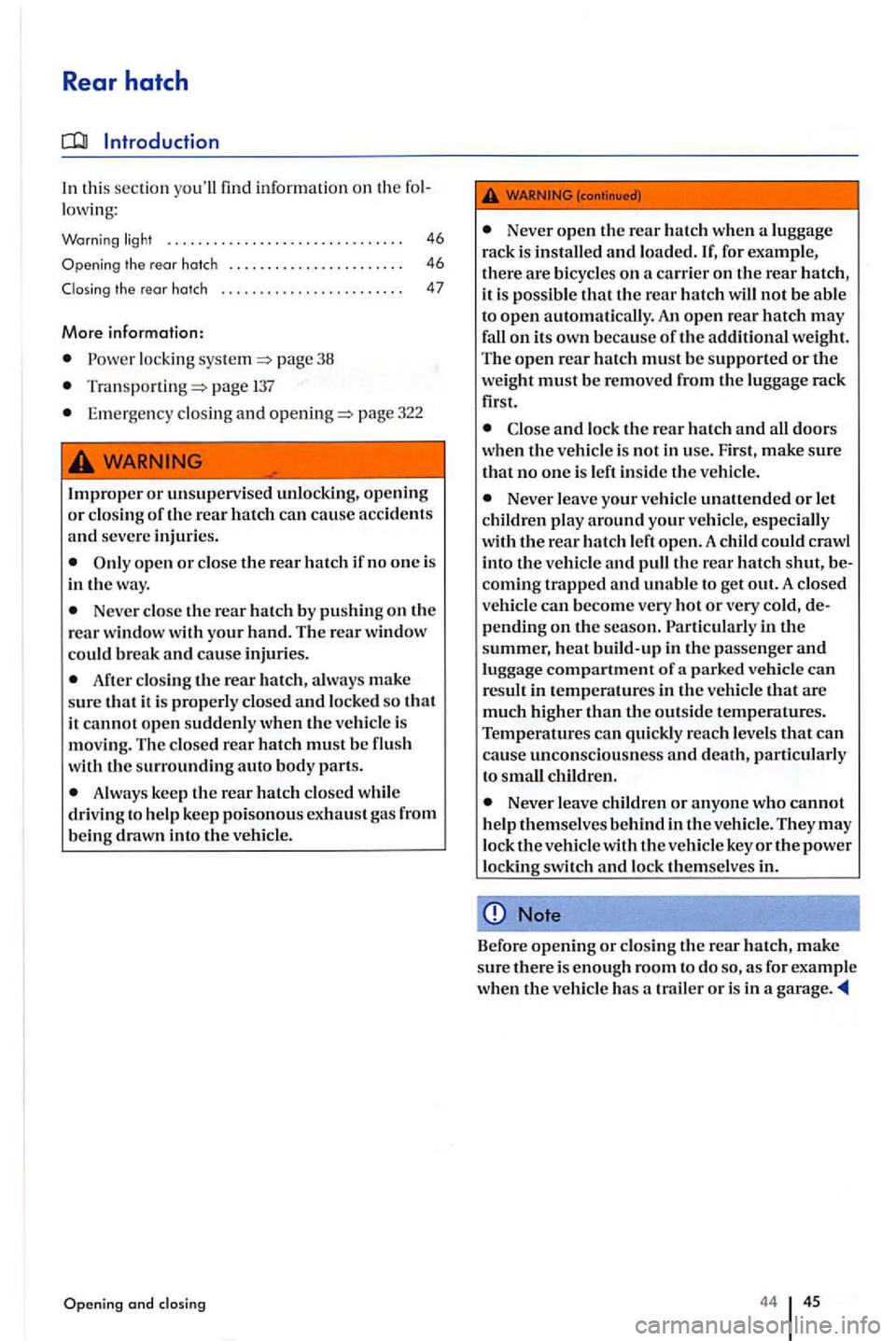
Rear hatch
this sectio n you'll find information on the following:
Warning light .............................. .
th e rear hatch .......•......... ......
Closing the rear hatch
More information:
Powe r loc kin g system page 38
page 137
Emergency closing and page 322
46
46
47
Improper or unsupervised unlocking, opening or closing of the rear hatch can cause accidents and severe injuries.
Never close the rear hatch by pushin g on the rear window with your hand. The rear window
could break and cause injuries.
After closing the rear hatch, always make sure that it is properly closed and locked so that it cannot open suddenly when the vehicle is moving. The closed rear hatch must be flu sh
with the surrounding auto body parts.
A lways keep the rear hatch closed while
driving to help keep poisonous exhaust gas from being drawn into the vehicle.
and closing
Never open the rear hatch when a luggage
rack is installed and load ed. for example,
there are bicycle s on a carrier on the rear it is possible that the rear hatch will not be able
to open automatically. An open rear hatch may fall on its own b eca use of the additional weight. The open rear hatch must be supported or the weight must be removed from the lu ggage rack
first.
Never leave your vehicle unattended or let
children play around your vehicle, especially
with the rear hatch left open. A child could crawl
into the vehicle and pull the rear hatch shut, becoming trapped and unable to get out. A closed vehicle can become very hot or very cold, depending on the season. in the summer, heat build-up in the passenger and luggage compartment of parked ve hicle can result in temperatures in the vehicle that are much higher than the outside temperatures. Temperatures can quickly reach levels that can cause unconsciousn ess and death, particularly
to small children.
Never leave children or anyone who cannot help themselves behind in the vehicle. They may lock the vehicle with the vehicle key or the power locking switch and lock themselves in.
Note
Before opening or closing the rear hatch, make sure there is enough room to do as for example when the vehicle has a trailer or is in a garage.
44 45
Page 68 of 541

Safety
Introduction
this sec tion y o u'll find informatio n on th e lowing:
Warning light ................ .... .. , .. .. , . . . 68
F ro ntal collis ions and l ows of ph ys ics . . . . . . . . . . . . 69
Whot happens to passengers no t wearing a safety
b elt? . . . . . . . . . . . . . . . . . . . . . . . . . . . . . . . . . . . . . . .
. . . . . . . . . .
. . 7 5
Safety belt exte nder . . . . . . . . . . . . . . . . . . . . . . . . . . 7 6
Safety belt retractor , pre te nsio ner, load limiter . . . . 78
Serv ice and d isposal of belt prete nsioners . . . . . . . 78
th e co nditi on of all safe ry belt s re gul arly. If a
sa fe ty belt s h ows da m age to we bbin g, b in din gs,
r et rac tors or bu ckles, have the safe ty belt replaced
b y an auth orized Volkswagen deafer or an rized Volk swagen Service rized Volkswagen deale rs and authorize d sw age n Se rv ice Fa cilities
Adju stin g th e seatin g pos ition
A ir ba g page
safety and c hild page
erl y position ed safety belt increa ses th e risk of severe pe rsona l injury or death. S afety belt s
offer optimum protection only whe n they are
u sed pro perly.
Safety belt s are the singl e most effecti ve
m eans availabl e to reduce th e r is k of seriou s jury and dea th in automobil e accid ents. For
your protection and that of your passengers ,
hicl e is moving.
Sitting properly and safely
Every person in the vehicle must b e properly
seat ed on
for e the vehicl e starts to move, and must k eep the belt properl y fastened while riding in the hicle. This applie s to the drive r and all g ers, ev en when ju st dri ving around town.
Alwa ys secure children in the vehicl e with a
restraint s ys te m appropriate for their age,
weight and page
Never attac h the safety belt to the buckl e o f another seat. Attachin g the safety belt to the wrong buckle will reduce safe ty belt
Never le t any obje cts or liquids get into the
s a fety belt latch and pre v ent it from working
prop erly. Alway s keep the belts clean. Dirty belt s
m ay n ot work correctly and can impair the
Neve r remove a safety belt w hil e the ve hicl e
i s moving. Doing so will increas e your risk of being injured or kill ed.
Ne ve r strap more than one person, includin g
s mall child ren, into any single safety belt .
N eve r let children or ba bies ride sitting on your lap and never place
Several layers of heavy clothing may
Ne ver wea r belt s ove r rigid or breakabl e jects in or on your clothing, such as eye glas ses,
p ens, keys etc., as these may ca us e injury.
Never use comfort clips or device s that creat slack in tl1e shoulder belt. Howev e r, spe cial clips may be require d for the correct use of some
c hild restraint sy ste m s.
Always ke ep saf ety belt buckl es fre e of anything
that may prevent the buckle from la tchin g sec urely.
Safe ty belt s off er optimum protecti on only when th e scat b ack is upright and belts a rc correctl y position ed on th e body
66 67
Page 69 of 541
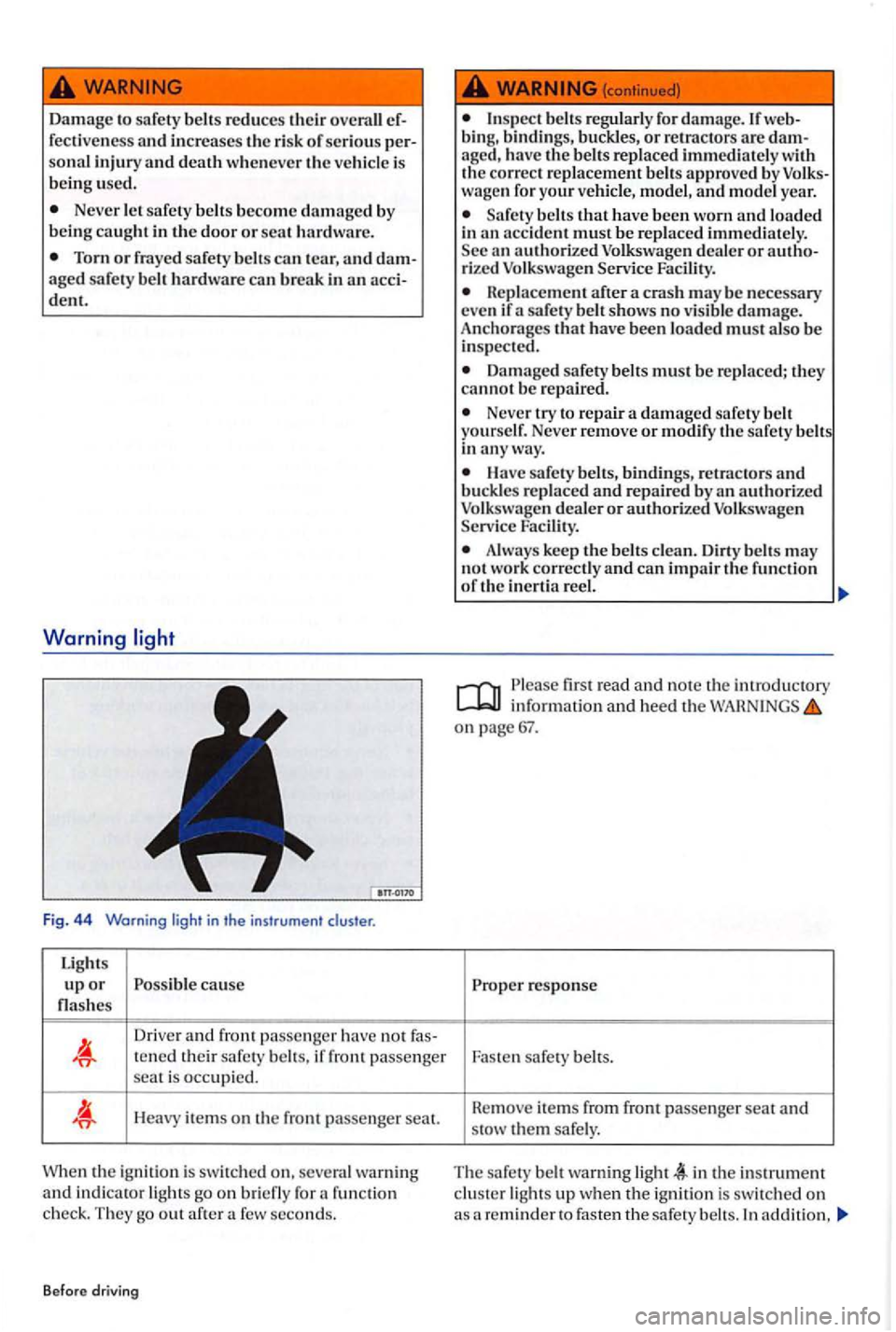
Damage to safety belt s reduces their ef
fectiven ess increase s the ris k of seriou s perinjury is
b ein g used.
Neve r safety belt s beco me damage d by
b ei ng caught in the door or seat hardware.
Torn or frayed safety te ar, and dam
aged safety hardware break in accident.
Warn ing
Fig. 44 Warning
Light s
u p o r cause
Driver and fron t pa sse nger have not fas-te n ed their safety if fron t passenger
sea t is occupied.
H eavy items on the front passenger seal.
the ignition is switched on. warning and in dica tor go on fun ction c he ck. They out after few seconds.
Before driving
for damage. If web
bin g, bindings, or re tra cto rs are damaged, have the approve d by wage n for your and year .
Safety that have bee n worn and in an accide nt must be
after a cras h may be nece ssary
eve n if safety sho ws no damage.
Anchorages that have been must
Damage d safety the y canno t b e re p air ed.
Neve r try to re pair a damage d sa fety Never remove or m odify th e safety
Have sa fety belts, binding s, retractor s and
or authorized Serv ice
k ee p the may
n ot work correct ly and ca n impair the function
o f th e in erti a
firs t rea d and note the introductory information and heed the on page 67.
Proper respo nse
Faste n safe ty
T he safety warning in the instrument
In add ition,
Page 76 of 541
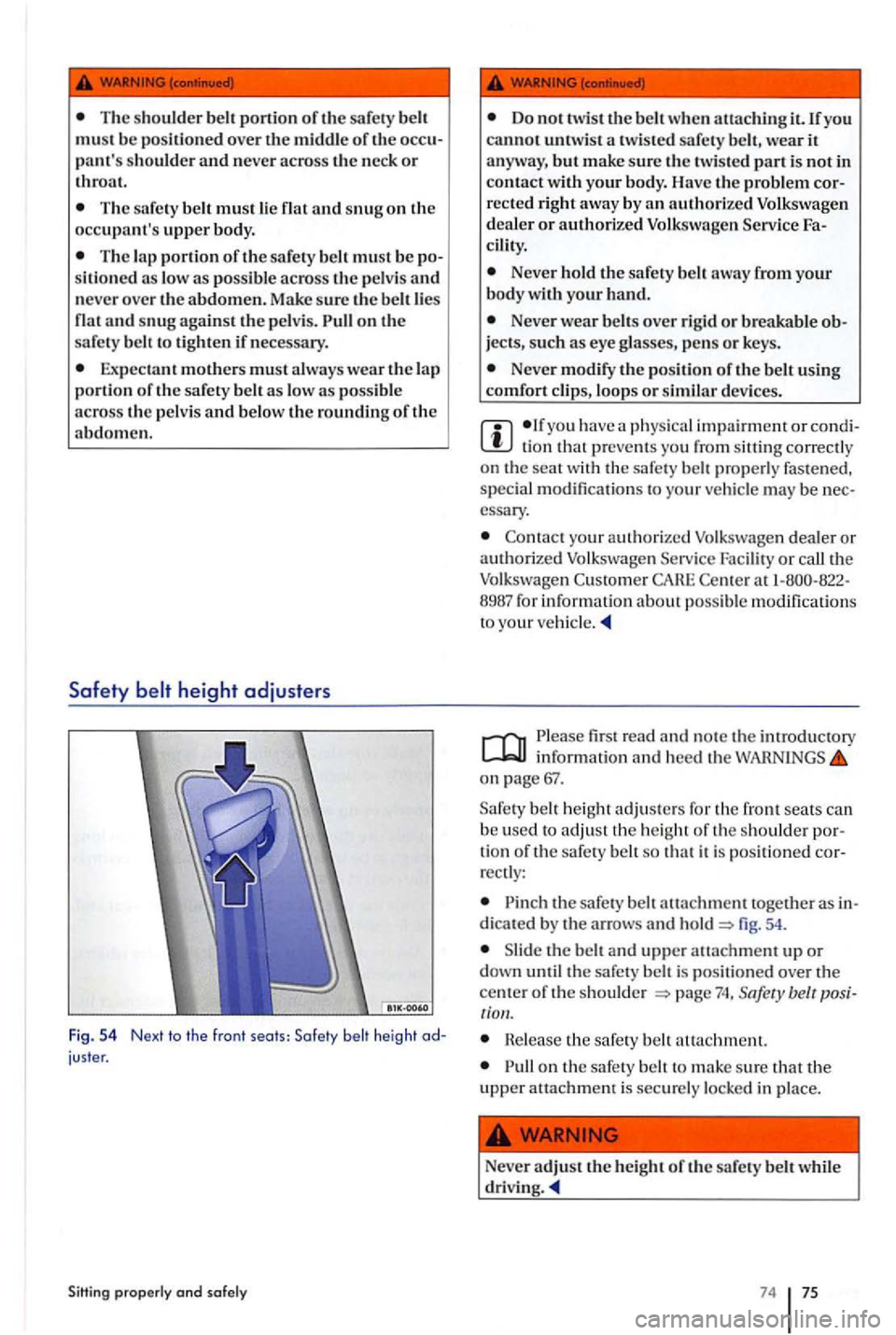
The sh o ulder belt portion of tJ1e safety must be positioned over the middle of the
T he sa fety belt must lie flat and snug on the
occupant's upper body.
T he la p portion of the safe ty belt must be sitioned as low as possible across the pelvis and n eve r over the abdomen. Make sure tJ1e belt lies
flat and snug against th e pelvis. Pull on the safety belt to tighten if necessary.
Expectant mothers mus t always wear the lap portion of the safety be lt as low as poss ibl e
a cross the pelvi s and below tJ1e rounding of the abdomen.
Safety
juster.
Sittin g ond safely
Do no t tw ist the belt wh en auaching it. If yo u cannot untwi st a twis te d sa fe ty belt , w ear it
anyway , but make sure the tw is te d p art is not in contact with your body. Have th e problem
cility .
Neve r hold the safet y belt away from your body your hand.
Never wear belt s over rigid or breakable
Neve r modify the po sition of the b elt usi ng
co mfort clips, loops or similar d evices .
tion that p reve nts yo u f rom siltin g correctly on th e seat w ith the safe ty belt p ro perly fastened,
spec ia l modifica tions to yo ur vehicle may be essary.
Contact your authorized Volkswage n dealer or
auth orized Volkswage n Facility or call th e Volksw agen CARE 8987 for informatio n abo ut po ssibl e modifications to you r vehicle .
Please fir st rea d and note the introduc tory informatio n and heed the on page
belt h eig ht adju ste rs for the front seats can
b e used to adj us t th e he ig ht of th e sh o uld er tio n of th e sa fety belt so th at it is po sit ioned
th e safe ty belt auachm emtogethe r as dica ted by the arro ws an d fig. 54.
th e belt and upper auachm ent up or d own th e safe ty belt is positioned over the
ce nter of th e should er tio n.
th e safe ty belt a uach mc nt.
on th e sa fe ty belt to mak e sur e th at th e
up pe r atta chment is sec ure ly loc ke d in place.
adjust the height of the safe ty belt while
Page 82 of 541
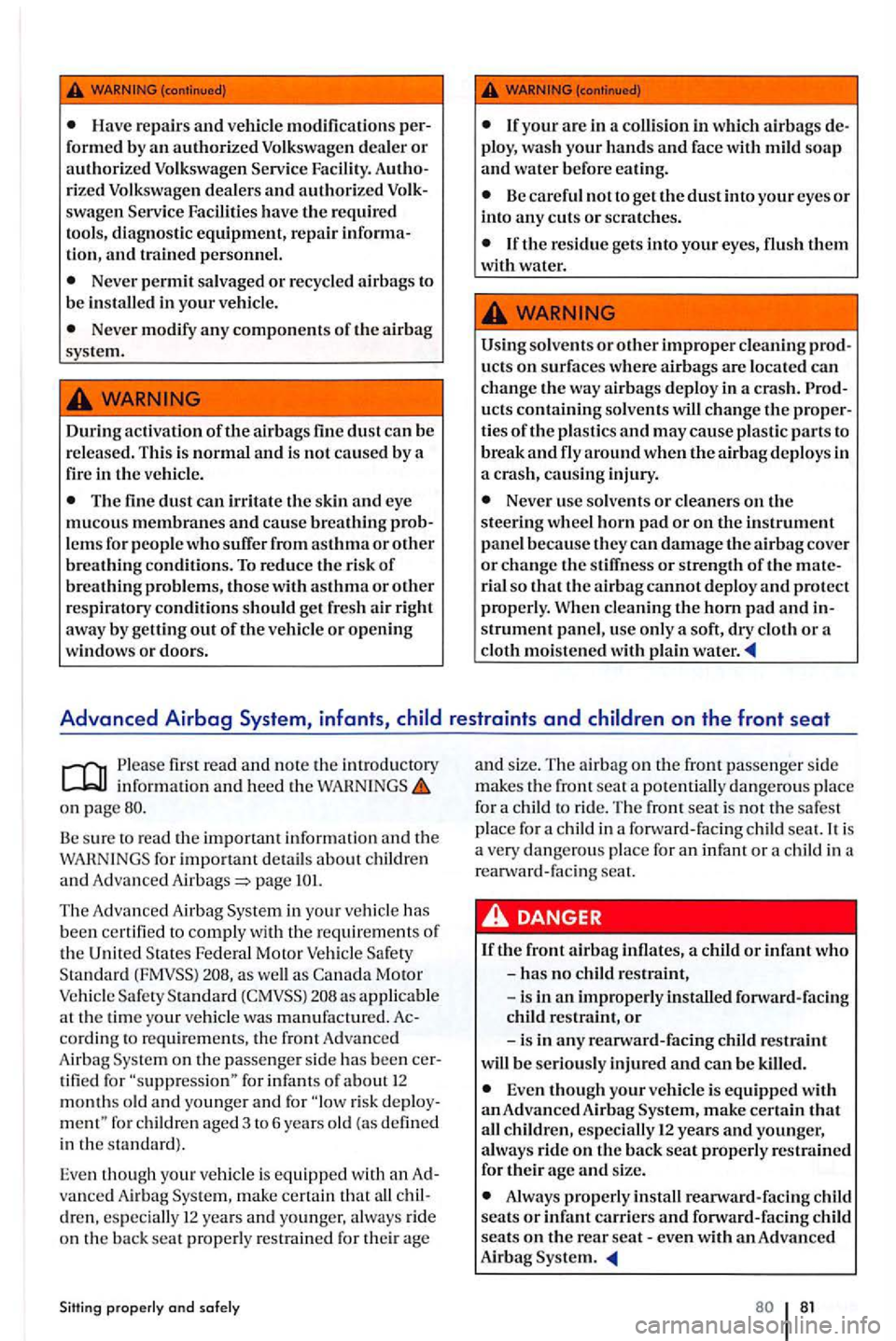
Have repairs and vehicle modification s
rized Volkswagen dealers and authorized swagen Facilities have the required
tool s, dia gnostic equipment, repair tion, and trained personnel.
Never permit salvaged or recycled airbags to be installed in your veh icle.
Never modify any components of the airbag syste m.
During activation of the
The fine dust can irritate the skin and eye muco us membranes and cause breathing lems for people who suffer from asthma or other breathin g conditions. To reduce th e risk of breathing probl em s, those with asthma o r o th er
r es piratory
Be careful no t t o ge t the dust into your eyes or
into any c uts or sc ratches.
Using so lve nts or other improper cleaning
u cts containing so lvents w ill ch ange the ti es of the plastic s and may cause plastic parts to break and fly around when the airbag deploys in a crash, causin g injury.
Never usc so lven ts or cleaners on th e
s teering wheel horn pad or on the instrument pan el b eca use they ca n damage the airbag cover or change the s tiffness or strength of the rial so that the airba g cannot deploy and protect properly. When cleaning the horn pad a n d strument panel, use onl y a soft, dry cloth or a
cloth moistened w ith plain water.
Please first read and note th e introductory informatio n and heed the WARN INGS on
Be sure to read the important inform ation and th e for important detail s about child ren
and Adva nce d Airbags
in you r ve hicl e has
been ce rtifi ed to comply wit h th e requirement s of the Unit ed Federal Moto r Vehicle as well a s Motor Vehicl e as a pplicabl e
at the time your vehicle was manufactured. co rding to req uirement s, th e front Advance d
A ir bag on th e passeng er side h as been tified for for infant s of about 12
months old and you nger and for risk for ch ildren aged 3 to 6 yea rs old {as defined
in the stand ard ).
Even th ough your vehicl e is equipp ed w ith an vance d Air bag mak e ce rtain that all dre n, es pecially 12 years and younge r, a lways ride
o n th e back seat properly restra ined for their a ge
Sitting properly and safely
and size. The airb ag on the front passenge r side m ak es the fron t seat a potentially dangerou s pla ce for a child ride. Th e front seat is no t th e sa fest
p lace for a child in a fo rward -faci ng chil d seat. is
a very dangerous place for an in fant or a child in a
r earward-fac ing sea t.
is in an improp erl y in stall ed for ward-faci ng
child res traint, or
in an y rearward- facing child restraint
will
be se riously injur ed and can be kill ed.
Eve n though your vehicl e is equipped with an Advance d Air bag make certain that aU children, especia lly years and you nger,
a lwa ys rid e o n the back seat properly restrained
for their age and s ize.
Always properly install reanvard-facing child seats or infant carriers and forward -faci ng c hild
s eats on the rear seat-even with an Advanced
81